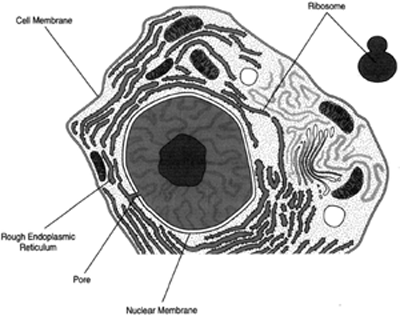Nuclear Membrane
The nuclear membrane is a double membrane much like the double membrane of the endoplasmic reticulum. An electron microscope reveals a light line sandwiched between two dark lines. This double-membrane system is called the nuclear envelope, and each unit membrane is believed to be composed of a central lipid layer sandwiched between layers of protein. Numerous pores can be seen in this envelope |
Figure 2-8 Greatly magnified cell showing the endoplasmic reticulum (ER): nuclear membrane, ribosome, rough endoplasmic reticulum, and cell membrane. |
(see figure 2-8): perhaps one-third of the surface is taken up by these perforations. The holes of the outer membrane appear contiguous with the channels of the endoplasmic reticulum. These holes are believed to allow the passage of materials from the nucleus to the cytoplasm and vice versa, although there is not universal agreement on this point. Some researchers claim that the pores of the nuclear envelope play no role in passage.
The inner and outer membranes of the envelope are connected to each other at the margins of the pores, and the pores appear to be lined. This lining is called the annulus, and while it fills much of the pore, a central channel remains. The channel may sometimes appear to be clogged with material. This material may be ribosomal, although this is not certain.




